Speedy Chess Basics Tutorial on the Moves
It's time to look at some chess basics. This is the logical next step after chess notation. Pawns start the game on the second rank. Pieces occupy the home rank behind the pawns.
Rooks in the corners, Knights next to the Rooks, Bishops next to the Knights, King and Queen in the center with the Queen on her color.
Rooks in the corners, Knights next to the Rooks, Bishops next to the Knights, King and Queen in the center with the Queen on her color.
The pawns are the infantry and usually move first in order to make way for the back row pieces to come out. The Knight is the only back row piece that needn't wait for the pawns to clear a path. Knights have the unique ability to jump over other pieces, friend or foe, on their way to their destination square. So the Knight can jump right over the pawns.
Usually when one or two pawns have been advanced, the Knights and Bishops are posted to strategically advantageous squares either in the center or controlling the center.
The Infantry go to the Pawn Shop
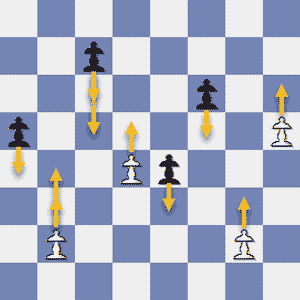
Chess Basics - Pawns on their starting blocks have the option of moving one or two squares but can only move forward one square on their subsequent moves
The pawns are the eight foot soldiers that start in front of the pieces. A pawn can move forward either one or two squares on his first move. On every move taken after that the pawn can move forward only one square. Unlike the other pieces in the game, the pawn can only move forward, never backward.
When capturing an enemy piece the pawn moves forward one square diagonally either left or right. He completes the capturing maneuver on the adjacent file where his victim had been. The pawn cannot capture a piece directly in front of him. He is blockaded by such a piece.
If a pawn reaches the final rank on the other side of the board he is almost always promoted to a Queen. Occasionally, if in the position it is more advantageous, the pawn can be under-promoted to a Rook, Bishop or Knight. Usually though chess basics will call for a Queen.
The Cavalry are Galloping Knights
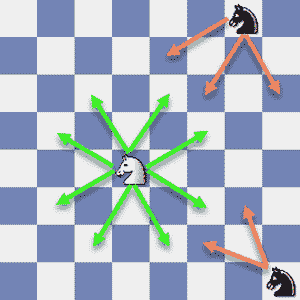
Chess Basics - Knights are much stronger in the center than they are on the edge or heaven forbid a corner. The closer your Knight is to the center the more options he has. They say a Knight on the rim is grim.
The Knight moves in a distinct fashion. It's two squares in any direction and then one square left or right from the original movement. It's not so easy to explain just in words alone. Maybe you'll get the idea quicker by looking at the diagram.
Another cool thing about the Knight is it's the only piece that is immune to blockades as it can jump over other pieces to get from one point to another. This makes the Knight very dangerous during close combat in closed positions.
The Knight is much better in the center than on the side of the board. See how the white Knight in the center of the board has eight possible moves. But the black Knight on the eighth rank has only three options. And the other black Knight right in the corner has just two. There are some cool apps out there to make you proficient at handling the Knight.
Standing a Prayer With the Bishops
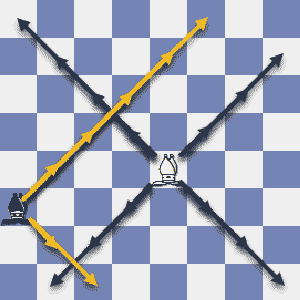
Chess Basics - A central position increases the Bishop's mobility giving him control over more squares
The Bishop is a wonderful piece. He moves along the diagonals and is often deployed in a supporting role in an attack on the enemy King. He is well designed for this purpose as his long range capabilities means he can control diagonals from remote areas deep in his own territory.
As you can see in the diagram, the Bishop's scope is also improved by taking a central position but often the most powerful Bishop is the one fianchettoed on the long diagonals at b2 or g2 for White or at b7 or g7 for Black.
Each side starts out with a light square Bishop and a dark square Bishop. No Bishop can access both color squares, they spend the game on one or the other. That's why a Bishop pair is considered very strong because when you have both of your Bishops you can reach all 64 squares. One Bishop can reach only 32.
The Rooks Hold the Key to the Castle
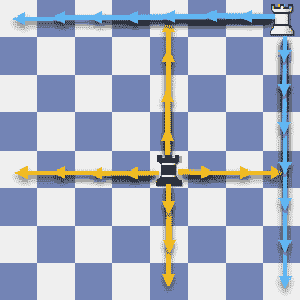
Chess Basics - Rooks command ranks and files. (e8 and h4 are accessible to both Rooks in this position)
The Rook is like the Bishop only instead of operating on the diagonals he controls the ranks and files. The Rook and King also have a unique castling move.
The Rook is an endgame piece coming into it's own when the files start to open up. Looking somewhat like a castle, the Rook is symbolic of a sentry in medieval times. It was also depicted by a chariot in other chess variants.
The Rook is the most powerful piece on the board after the Queen. It is also involved in more endgames than any other piece. Knowledge of Rook and pawn endings are crucial to becoming a strong chess player.
Tapping the Queen's Majestic Power
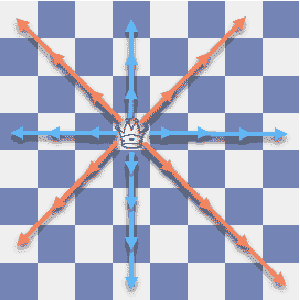
Chess Basics - The Queen's powers are a combination of those of the Rook and the Bishop
Now contemplate the full extent of the Queen's power. If you count the square the Queen is situated in you will notice that from a central location she controls half the board.
Only 32 of the 64 squares are out of her reach while she can reach the remaining 31 in a single move. As you can see the Queen can bring pressure to bear on the enemy in three or four different points at any time.
If you understand when and how to bring your Queen into the game you can use her power to decide the game in your favor. The big hint for beginners is to resist the understandable urge to use the Queen for lone raids early on. This will back-fire against good players.
The King's Flame Must Keep Burning
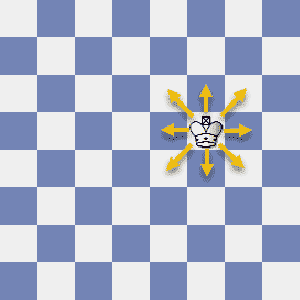
Chess Basics - The King's move is identical to that of the Queen except instead of a limitless range he can only move one square at a time
The King is the most important piece in the game. You must capture your opponent's King to win the game. The King can and should be brought to relative safety early on by castling.
Castling is a special chess move in which the King and Rook combine. The rules for castling are as follows: the King is moved, from its original square, two squares toward either Rook on the same rank. Then that Rook is moved over the King to the square immediately next to the King.
Apart from castling, the King moves to any adjoining square that is not commanded by an enemy piece. The King is a relatively strong piece, about the power of a minor piece. He should however be kept out of danger for much of the game. In the endgame the King moves from the periphery to center-stage.
Moving On
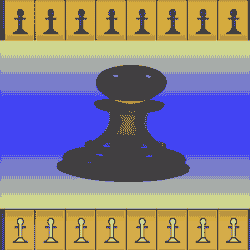
That's a good overview of the game and I believe enough to leave you ready to play your first game of chess. You may want to study chess basics a little deeper.
Later you can get stuck into strategy, how to rack up many chess victories against your opponents. It's probably a good idea to nail the rules first though but that won't take long.
You're well on your way now. Every aspect of the rules are laid out here for you in greater detail. Now that you have the broad strokes let's drill down on how the pawn moves.

